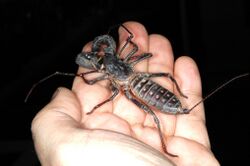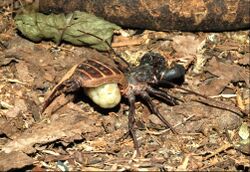Biology:Mastigoproctus giganteus
| Mastigoproctus giganteus | |
|---|---|

| |
| Scientific classification | |
| Domain: | Eukaryota |
| Kingdom: | Animalia |
| Phylum: | Arthropoda |
| Subphylum: | Chelicerata |
| Class: | Arachnida |
| Order: | Uropygi |
| Family: | Thelyphonidae |
| Subfamily: | Mastigoproctinae |
| Genus: | Mastigoproctus |
| Species: | M. giganteus
|
| Binomial name | |
| Mastigoproctus giganteus (Lucas, 1835)
| |
| Synonyms | |
|
Thelyphonus giganteus | |
Mastigoproctus giganteus,[1] the giant whip scorpion, also called the giant vinegaroon or grampus,[2][3] is a species of whip scorpions in the family Thelyphonidae.
Description
This species can grow to be 40–60 millimetres (1.6–2.4 in) long, excluding the tail.[2][3] They have six legs used for movement, two long antenniform front legs that they use to feel around for prey and detect vibrations, and two large pedipalps modified into claws that they use to crush their prey.[3] They have a long, thin, whip-like tail, the origin of the common name whipscorpion. From the base of this tail they can spray a substance composed of 85% acetic acid in order to defend themselves.[2] Acetic acid is the main component of vinegar, so the spray smells strongly of vinegar, leading to the common name "vinegaroon".[2][3]
Mastigoproctus giganteus have eight eyes: two in a pair on the front of the head and three on each side of the head.[3] These eyes are very weak, so Mastigoproctus giganteus navigates mostly by feeling with its long front legs, tail, and pedipalps.[3]
Phylogeny
Mastigoproctus giganteus is included with the Tetrapulmonata in a clade within the pulmonate Arachnida (those with book lungs), most closely related to spiders Araneae and stinging scorpions Scorpiones, which they feed on. It is composed of the extant orders Thelyphonida (whip scorpions), Schizomida (short-tailed whip scorpions), Amblypygi (tail-less whip scorpions) and Araneae (spiders) This 2019 cladogram summarizes:[4]
| Chelicerata |
| ||||||||||||||||||||||||||||||||||||
Pedipalpi is further classified. The Schizomida and Thelyphonida likely diverged in the late Carboniferous, somewhere in the tropics of Pangaea.[5]
| Pedipalpi |
| ||||||||||||
| Thelyphonida ( whip scorpions) |
| ||||||||||||||||||||||||
Habitat
Mastigoproctus giganteus lives in the southern US and in Mexico at elevations up to 6000 feet.[6] It preys on various insects, worms, and slugs.[7] It is an efficient predator that feeds at night on a variety of Arthropods, primarily insects such as cockroaches and crickets, as well as millipedes and other arachnids. It has even been recorded feeding on small frogs and toads. It uses its large pedipalps to hold prey, while the chelicerae tear and bite the prey.[8]
Mastigoproctus giganteus is the only species of family Thelyphonidae that occurs in the United States,[9] including Arizona, Florida, New Mexico, Oklahoma, and Texas.[10]
Vinegaroons are efficient predators of scorpions and are sometimes acquired for that purpose.[11] Mastigoproctus giganteus may be eaten by raccoons, coatis, armadillos, skunks, bears, hogs and peccaries,[12] ground birds such as roadrunners, lizards, and tarantulas.[13]
Life cycle and reproduction
Mastigoproctus giganteus typically lives 4 to 7 years, but the female reproduces only once, producing about 40 offspring which she protects and feeds in their early lives.[6]
Males fight each other at night in fierce battles for the privilege of mating with a female also at night.[6]
Survivability of young is improved by continual care by the mother.[6]
Economic impact
Mastigoproctus giganteus is regarded as beneficial to agriculture and human residences by controlling stinging scorpions, insects, and spider populations.[6]
As pets
This species is sold in the exotic animal trade as pets.[14]
Non venomous they can be kept as individual adults or groups of juveniles in terrariums with places to dig and hide, fed insects twice a week especially crickets and flies. Mastigoproctus giganteus can be handled gently with care to avoid being bitten, pinched, or sprayed with acid when the arachnid feels threatened.[6]
Subspecies
- Mastigoproctus giganteus giganteus (Lucas, 1835) — Southern USA
- Mastigoproctus giganteus excubitor (Girard, 1854) — University Of Florida[15][16]
- Mastigoproctus giganteus rufus mexicanus (Butler, 1872) — Mexico
- Mastigoproctus giganteus giganteus (Lonnberg, 1879) — Florida to Arizona
- Mastigoproctus giganteus scabrosus (Pocock, 1902) — Mexico
- Four subspecies A, B, C, and D are under study in The
American Museum of Natural History, New York City and The National Autonomous University of Mexico.[17]
References
- ↑ "Mastigoproctus giganteus". Integrated Taxonomic Information System. https://www.itis.gov/servlet/SingleRpt/SingleRpt?search_topic=TSN&search_value=746629.
- ↑ 2.0 2.1 2.2 2.3 Kern Jr., W.H.; Mitchell, R.E.. "Giant Whip Scorpion - Mastigoproctus giganteus giganteus (Lucas, 1835)". UF IFAS. http://entnemdept.ufl.edu/creatures/misc/misc/giant_whip_scorpion.htm. Retrieved 23 May 2016.
- ↑ 3.0 3.1 3.2 3.3 3.4 3.5 Miner, Angela. "Mastigoproctus giganteus". University of Michigan Museum of Zoology. http://animaldiversity.org/accounts/Mastigoproctus_giganteus/. Retrieved 23 May 2016.
- ↑ Howard, Richard (2019). "Exploring the evolution and terrestrialization of scorpions (Arachnida: Scorpiones) with rocks and clocks". Organisms Diversity & Evolution (Springer) 19: 71–86. doi:10.1007/s13127-019-00390-7. https://link.springer.com/article/10.1007/s13127-019-00390-7. Retrieved 1 September 2022.
- ↑ Clouse, Ronald M.; Branstetter, Michael G.; Buenavente, Perry; Crowley, Louise M.; Czekanski‐Moir, Jesse; General, David Emmanuel M.; Giribet, Gonzalo; Harvey, Mark S. et al. (2017). "First global molecular phylogeny and biogeographical analysis of two arachnid orders (Schizomida and Uropygi) supports a tropical Pangean origin and mid-Cretaceous diversification" (in en). Journal of Biogeography 44 (11): 2660–2672. doi:10.1111/jbi.13076. ISSN 1365-2699.
- ↑ 6.0 6.1 6.2 6.3 6.4 6.5 "Mastigoproctus giganteus". University Of Michigan. https://animaldiversity.org/accounts/Mastigoproctus_giganteus/.
- ↑ "Species Mastigoproctus giganteus - Giant Vinegaroon". BugGuide.Net. http://bugguide.net/node/view/29752. Retrieved 2010-07-30.
- ↑ "Mastigoproctus giganteus". Animal Diversity. https://animaldiversity.org/accounts/Mastigoproctus_giganteus/. Retrieved 2022-07-07.
- ↑ "Giant Whip Scorpion". UOF. https://entnemdept.ufl.edu/creatures/misc/misc/giant_whip_scorpion.htm.
- ↑ Borror, Triplehorn & Johnson 1989; Levi et al. 1990; Rowland & Cooke 1973.. "Vinegaroon". Texas A&M. https://texasinsects.tamu.edu/vinegaroon/.
- ↑ Thompson, Clay. "Makes a good pet". Azcentral. https://www.azcentral.com/story/claythompson/2014/10/30/vinegaroon-scorpion-pests-insects/18188213/.
- ↑ "Natural Enemies". UOF. https://entnemdept.ufl.edu/creatures/misc/misc/giant_whip_scorpion.htm.
- ↑ "Vinegaroon". Toronto Zoo. https://www.torontozoo.com/animals/Vinegaroon#:~:text=Enemies%20include%20medium%20sized%20mammal,one%20another%2C%20and%20possibly%20scorpions..
- ↑ "Giant vinegaroon - Mastigoproctus giganteus". exotic-pets.co.uk. https://www.exotic-pets.co.uk/giant-vinegaroon.html. Retrieved 2019-06-17.
- ↑ Barrales-Alcalá, Diego. "SYSTEMATIC REVISION OF THE GIANT VINEGAROONS OF THE MASTIGOPROCTUS GIGANTEUS COMPLEX (THELYPHONIDA: THELYPHONIDAE) OF NORTH AMERICA". AMNH. http://research.amnh.org/users/lorenzo/PDF/Barrales_et_al_2018.pdf.
- ↑ "Synonymy". UOF. https://entnemdept.ufl.edu/creatures/misc/misc/giant_whip_scorpion.htm.
- ↑ Barrales-Alcalá, Diego. "Vinegaroon? It's Actually Seven Different Species". Bulletin of the American Museum of Natural History. https://www.amnh.org/explore/news-blogs/research-posts/the-giant-north-american-vinegaroon-it-s-actually-seven-different-species.
Wikidata ☰ Q3020933 entry










